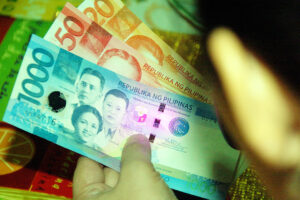




Monthly Economic Update: One for the road
 DOWNLOAD
DOWNLOAD

Inflation Update: Still low, still slow
 DOWNLOAD
DOWNLOAD

Philippines Trade Update: Exports momentum continues
 DOWNLOAD
DOWNLOAD


Peso slips on hawkish comments from Fed officials

THE PESO slipped against the dollar on Thursday amid hawkish signals from US Federal Reserve officials.
The local currency closed at PHP 55.01 versus the greenback on Thursday, down by three centavos from Wednesday’s PHP 54.98 finish, Bankers Association of the Philippines data showed.
The peso opened Thursday’s session stronger at PHP 54.86 per dollar. Its intraday best was at PHP 54.825, while its weakest showing was at PHP 55.16 against the greenback.
Dollars traded went up to USD 1.276 billion on Thursday from USD 1.03 billion on Wednesday.
The peso weakened due to hawkish signals from Minneapolis Fed President Neel Kashkari and Atlanta Fed President Raphael Bostic, Rizal Commercial Banking Corp. Chief Economist Michael L. Ricafort said in a Viber message.
“The peso weakened amid hawkish remarks from Fed official Kashkari who supported a 50-bp (basis point) increase in the US policy rate this month,” a trader likewise said in an e-mail.
Mr. Kashkari said on Wednesday that he was open to a 25- or 50-bp rate hike at the Fed’s next policy meeting after the US personal consumption expenditures price index shot up 0.6% last month after gaining 0.2% in December, Reuters reported.
He added that rates may ultimately need to go higher than the 5.4% level.
Meanwhile, Mr. Bostic said in an essay on Wednesday that he feels a rate set in a range of from 5% to 5.25% would be adequate
The Fed hiked its target interest rate by 25 bps at its Jan. 31 to Feb. 1 meeting to a range between 4.5% and 4.75%.
Since March 2022, the US central bank has raised rates by a total of 450 bps. Its next policy meeting is on March 21-22.
For Friday, the trader said the peso could weaken further ahead of a potentially strong US jobless claims report.
The trader expects the peso to trade between PHP 54.90 and PHP 55.15 against the greenback on Friday, while Mr. Ricafort gave a forecast range of PHP 54.90 to PHP 55.10.
Peso weakness to persist
Meanwhile, MUFG Global Markets Research sees the peso facing more downward pressure amid the dollar’s resurgence and expectations of elevated inflation.
“The peso is facing headwinds in the near term from renewed dollar strength. However, several factors argue against excessive weakness,” MUFG Global Markets Research said in a report on Thursday.
It sees the peso ending the first quarter at PHP 55.50 a dollar, weaker than its previous estimate of PHP 54.75 a dollar and worse than its February close of PHP 55.33.
By the end of the second quarter, the peso could strengthen to PHP 55 against the greenback and to PHP 54.50 by the end of the third quarter before closing 2023 at PHP 54 a dollar, it said.
MUFG Global Markets Research previously saw the peso finishing the second quarter at PHP 54.50, the third at PHP 54.25, and the year at PHP 53.50 against the greenback.
It said the peso may see extended weakness due to expectations of high inflation, which could force the Bangko Sentral ng Pilipinas (BSP) to raise borrowing costs aggressively, reducing its interest rate differential with the US Federal Reserve.
“January inflation was red-hot, surpassing expectations by more than 1 ppt. (percentage point)… The BSP (Bangko Sentral ng Pilipinas) has significantly raised its inflation forecast for 2023, from 4.5% to 6.1%. If realized, it will be higher than the 5.8% seen in 2022 and represent a second consecutive year above the 2.0-4.0% target. The central bank now sees higher inflation in 2024 as well (3.1% from 2.8% previously),” MUFG Global Markets Research said.
“Given these, we expect the BSP to hike to at least 6.50% in 2023, with some chance of more rate hikes in the coming months. The “higher for longer” rate outlook for the Philippines will likely limit yield differentials compared to the US,” it added.
The BSP raised benchmark interest rates by 50 basis points (bps) at its February 16 meeting, bringing its key rate to 6%, the highest in nearly 16 years.
The Monetary Board has increased borrowing costs by a total of 400 bps since May 2022 to tame inflation.
BSP Governor Felipe M. Medalla earlier said the Monetary Board might hike policy rates again at its next meeting on March 23 to quell demand-side pressures and manage inflation expectations.
He said a 25-bp hike is the “most likely” option this month due to a “great possibility” that inflation has already peaked in January as non-monetary measures are starting to dampen price increases.
MUFG Global Markets Research said it expects the peso to gain some ground against the dollar in the second half as it sees economic conditions normalizing.
“Despite continued demand for investment-related imports, net exports are likely to be less of a drag going forward, helped by lower import bills and the expected recovery in Chinese tourist arrivals. Remittances growth should hold up and inflation will moderate by the end of the year,” it said. — AMCS with Reuters
This article originally appeared on bworldonline.com





 By BusinessWorld
By BusinessWorld